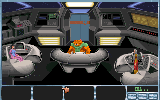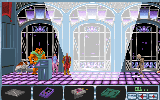

Computer Graphics Memory Disk Space
Minimum 386/25 w/ CD-ROM VGA 590K free RAM 2MB
Control: Mouse
Sound: Sound Blaster (SB), SB Pro, Covox sound Master II. Pro-Audio
Spectrum 16, Roland RAP-10
Notes: Does not support MCGA graphics
Reviewed version on: 486/66 w/ 16MB RAM, SB 16, Diamond Viper video
card
Thus begins RETURN TO RINGWORLD (R2RW), Tsunami's sequel to their RINGWORLD: RETURN OF THE PATRIARCH. R2RW is a fairly typical science fiction adventure game that is distinguished by being set in Larry Niven's Known Space universe. The game is chock full of puzzles of many varieties, has a decent storyline, and is generally enjoyable to play.
R2RW begins at the point where the previous Ringworld game ended. I have not played Return of the Patriarch and so cannot compare it to R2RW. However, not having played the prior game does not impede playing the sequel. The brief manual provides a synopsis of Patriarch and the characters in R2RW engage in a conversation that does a very nice job of motivating the new game from the endpoint of the previous one. In addition, there is a computer onboard your ship that contains a database that is filled with detail about the races, planets, artifacts etcetera that populate Niven's Known Space. This is an excellent idea because it quickly introduces players unfamiliar with Niven's books to a universe that is rich in both content and detail. It does, however, place a heavy reading load on the payer at the beginning of the game. There are clues to several puzzles buried in the database and thus it is a good idea to devote one of your save-game slots to keeping a position from before the point at which you leave the ship.
The interface is a joy. You are provided with the basic adventure game functions such as Walk, Talk, Look and Use. Each is indicated by a different cursor and can be accessed by either a mnemonic keypress (e.g., "L" for Look) or by right-clicking anywhere onscreen which produces a graphic menu. All of these functions work easily and well. When in Look mode, pointing and clicking on any area of the screen produces a response. Sometimes you get a generic description of the scene but many features in the environment have unique descriptions. The narrator has a James-Earl- Jonesish voice that is easy and pleasant to listen to. Graphics are more than adequate but not exceptional. Cut scenes advance the story, are generally entertaining, but, again, are not exceeptional. Sound effects are very good (I especially enjoyed the deep thrumming of the ship in the early stages of the game) and the music is varied and not annoying. I was never able to find an adequate balance between sound and music volumes and ended up barely hearing much of the music so as to be able to hear the voices.
You have a party of three individuals at your disposal: Quinn, a male human "problem solver", Miranda, a female human engineer, and Seeker, a male Kzin (a race of large cat-like beings) pilot. With the notable exception of Miranda, the voice actors are professional and competant. Miranda is supposed to be somewhat abrasive and this, combined with the, at times, excruciatingly amateur level of her vocal characterization, results in some very annoying interchanges when Miranda is a participant.
One of the enjoyable aspects of the game is that you can switch back and forth between the three characters at will. There are points in the game at which advancement is impossible unless you are playing the right character. This is not always handled well. There is at least one point in the game where you cannot advance until an action is taken by one of the characters. However, taking this action will result in failure until the other two characters have completed certain actions. These actions by the other two characters have nothing to do with the action the first character needs to take. None of this is made clear to the player. At some point it will appear that all three characters are stuck; when that happens, an action you probably took with one of the characters that was unsuccessful earlier in the game will now succeed.
The puzzles are many, varied and fair. This is one of the real strengths of the game. Most of the puzzles only have one solution. This means that sometimes you will spend time trying to achieve a solution that should work but does not. In addition, the distribution of puzzle types throughout the game is a bit uneven. There are a number of mazes in R2RW; some of them are three-dimensional and some are quite clever. I don't mind mazes but I found myself cringing when I encountered the third or fourth maze in a row.
R2RW has one characteristic that I found both annoying and tedious. The Ringworld is an extremely large construct. The game designers apparently decided to give the player an idea of its size by inserting screen after screen after screen of similar or identical graphics on the way from here to there. For example, at one point your characters must walk along the top of the Ringwall to find a monorail car. Rather than have you traverse a screen or two, the designers force you to cross about ten. This sort of thing happens time and time again and has two unfortunate consequences. First, no matter how far you go in any direction, you are never sure if you are going the right way. Second, the typical puzzle-solving procedure of "well, now that I've done this, maybe I should go back there and try that" results in having to cross unending screens that you've seen a hundred times before. R2RW really needs a feature like the one used in MYST that allows you to jump from one location to another once you've already been to both.
Although R2RW has its problems, the game is strong where it counts. The story is interesting, there are lots of puzzles and the puzzles are fair. The graphics, sound and voices generally enhance the playing experience and the interface is very well designed. If you like SF adventure games, you'll probably enjoy R2RW.